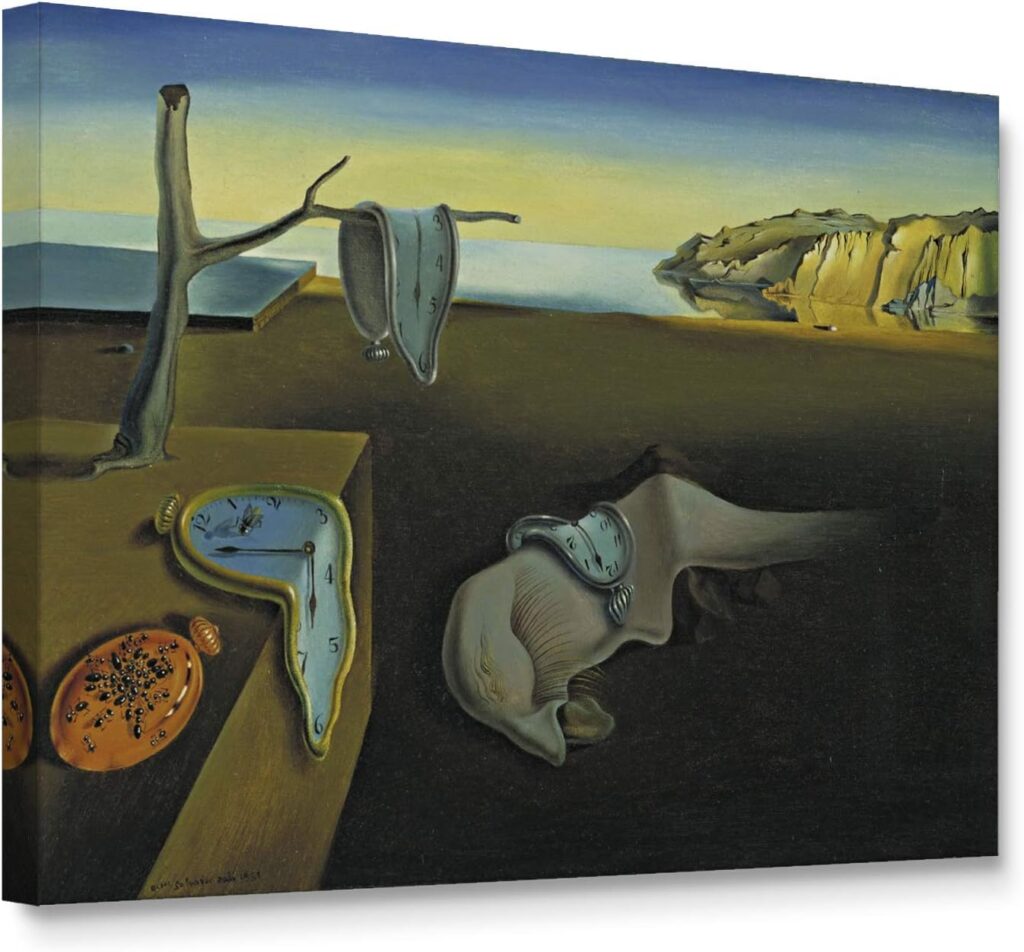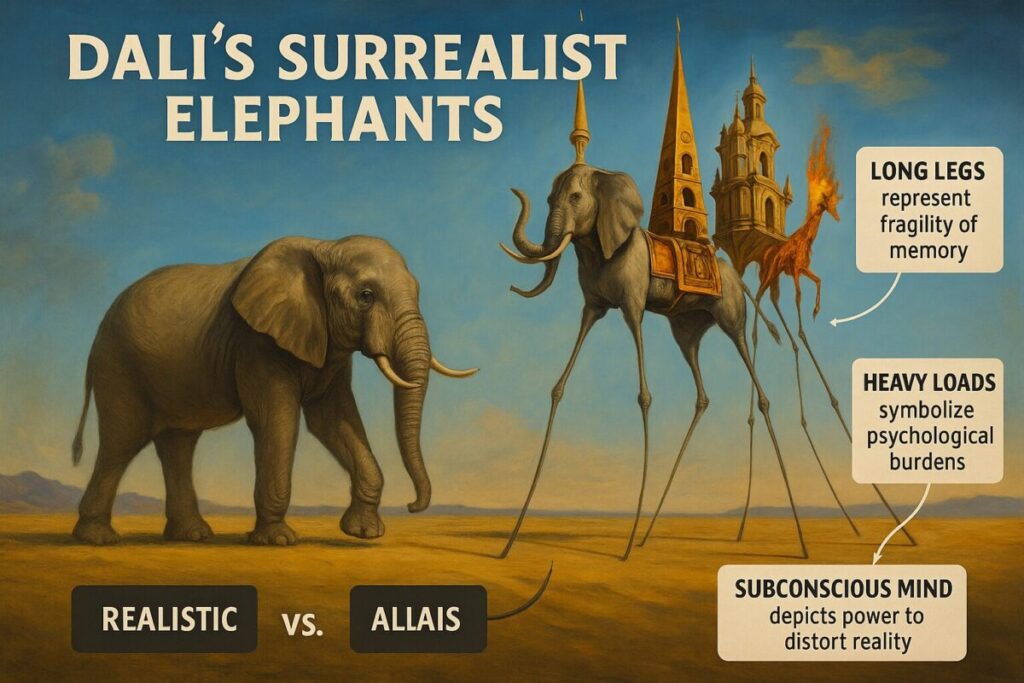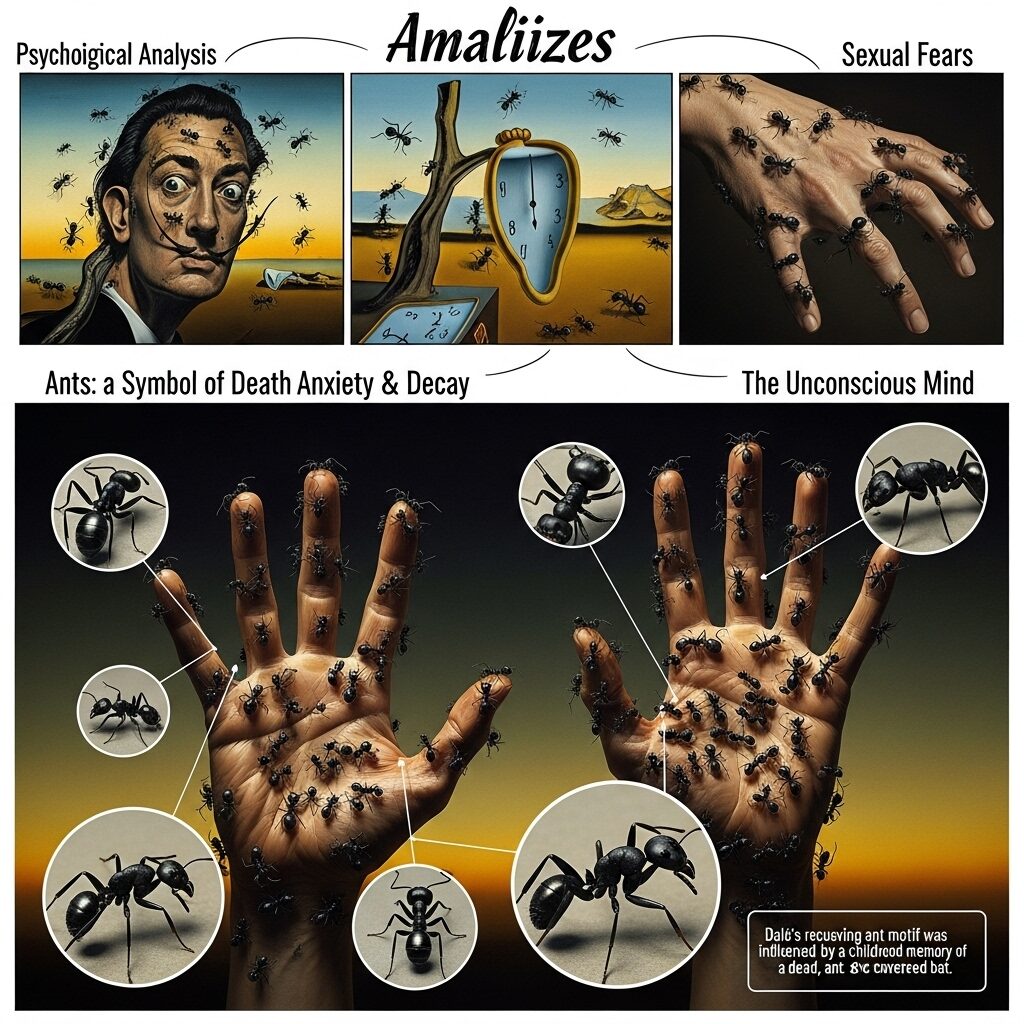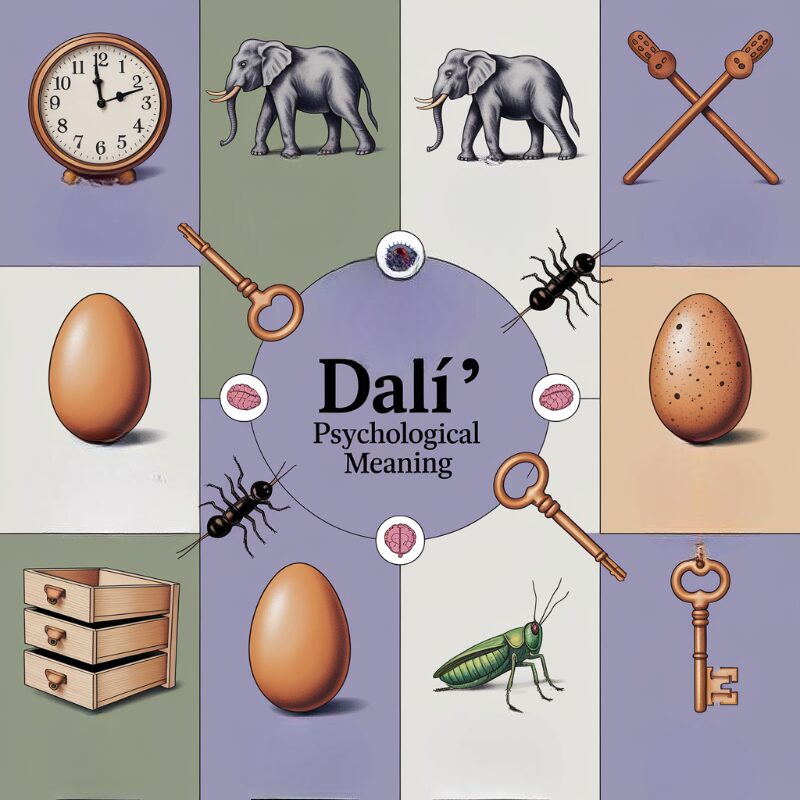Salvador Dalí, the flamboyant Spanish surrealist with the iconic mustache, created some of the most puzzling and fascinating artworks in history. But beneath the surface of his dreamlike paintings lies a complex web of hidden symbolism in Salvador Dalí’s art that reveals deep psychological meanings and personal fears. From melting clocks that seem to drip like honey to elephants walking on impossibly thin legs, every strange element in Dalí’s work tells a story about the human mind, our deepest anxieties, and the mysteries of the subconscious.
Key Points Summary

- Dalí’s symbols stem from Freudian psychology and personal experiences
- Melting clocks represent the fluidity of time in dreams and memory
- Ants symbolize death, decay, and sexual anxiety from childhood trauma
- Elephants with long legs show the paradox of memory’s weight and fragility
- Drawer-filled bodies represent compartmentalized memories in the mind
- Understanding these symbols unlocks deeper meaning in surrealist art
Decoding Dalí’s Visual Language
Understanding Salvador Dalí symbolism meaning requires us to think like a detective. Each painting is filled with clues that point to deeper psychological truths. Dalí didn’t just paint strange images to shock people – though he certainly enjoyed doing that! Instead, he used what psychologists call the “paranoiac-critical method,” a technique that allowed him to tap into his subconscious mind and bring hidden fears and desires to the surface.
This approach was heavily influenced by Sigmund Freud, the famous psychologist who believed our dreams reveal our deepest thoughts. When Dalí finally met Freud in 1938, the encounter validated his artistic approach. Freud reportedly said that while he considered surrealists “complete lunatics,” Dalí showed him “a young Spaniard with eyes like candid flames.”

The key to Dalí art symbols interpretation lies in understanding that every bizarre element serves a purpose. Nothing in a Dalí painting is random. The hidden meanings in famous paintings often connect to universal human experiences – fear, love, death, and the passage of time.
The Psychology Behind Dalí’s Symbols
Freudian symbolism in art plays a crucial role in understanding Dalí’s work. The artist was fascinated by psychoanalysis and believed that art should explore the unconscious mind. This connection to psychology explains why Dalí psychoanalysis art feels so unsettling yet familiar – it taps into fears and desires we all share but rarely acknowledge.
Dalí’s symbols fall into two categories: personal symbols based on his own experiences and universal symbols that represent common human fears. His childhood in Catalonia, Spain, deeply influenced his artistic vocabulary. The landscape of his hometown appears repeatedly in his work, transformed into dreamlike settings where impossible things happen.
The artist’s relationship with his wife and muse, Gala, also shaped his symbolic language. She appears in many forms throughout his work, sometimes as a Madonna figure, other times as a mysterious presence watching over strange scenes.
Most Common Symbols in Dalí’s Work
Melting Clocks: Time Becomes Fluid
Perhaps the most famous example of hidden symbolism in Salvador Dalí’s art appears in “The Persistence of Memory” – those soft, drooping timepieces that look like melted cheese. But what does Salvador Dalí melting clocks meaning actually represent?

These “soft watches” symbolize the relative nature of time, especially in dreams and memory. When we dream, minutes can feel like hours, or years can pass in an instant. Dalí wanted to show how our minds experience time differently from clock time. The melting also suggests that our rigid understanding of time is just an illusion – everything eventually breaks down and becomes fluid.
Ants: Symbols of Death and Decay
Salvador Dalí ants symbolism stems from a traumatic childhood experience. Young Dalí once found a dead bat covered in ants, and this image haunted him throughout his life. In his paintings, ants often crawl over hands, faces, or objects, representing death, sexual anxiety, and the inevitable decay that comes to all living things.
The ants appear most famously in works like “Un Chien Andalou” (the surrealist film he made with Luis Buñuel) and “The Great Masturbator.” They represent what psychologists call “thanatos” – the death drive that Freud believed exists in all humans.
Elephants: Memory’s Paradox

Dalí elephant symbolism presents one of his most striking visual metaphors. These massive creatures balanced on impossibly thin, spider-like legs carry heavy loads – obelisks, burning objects, or castles. The contrast between their enormous weight and fragile supports represents the paradox of memory itself.
Our memories can carry tremendous emotional weight, yet they rest on surprisingly fragile foundations. Like Dalí’s elephants, memories can be both powerful and delicate, capable of collapsing under their own weight or external pressure.
Drawers in Human Bodies

The recurring image of Dalí drawer symbolism shows human figures with wooden drawers built into their torsos and limbs. These represent the compartmentalized nature of memory and consciousness. Just as we organize papers in desk drawers, our minds organize experiences into different mental “compartments.”
Some drawers are pulled open, revealing mysterious contents, while others remain tightly shut. This symbolizes how some memories are easily accessible while others remain locked away in our unconscious minds.
| Symbol | Psychological Meaning | Personal Connection |
|---|---|---|
| Melting Clocks | Fluid nature of time in dreams | Einstein’s theory of relativity |
| Ants | Death, decay, sexual anxiety | Childhood trauma with dead bat |
| Long-legged Elephants | Paradox of memory’s weight | Bernini’s elephant obelisk in Rome |
| Body Drawers | Compartmentalized consciousness | Freudian theory of mind structure |
| Crutches | Need for support, weakness | Fear of impotence and failure |
Personal vs Universal Symbolism in Dalí’s Art
Understanding Dalí surrealism symbols requires recognizing the difference between personal and universal meanings. While some symbols relate specifically to Dalí’s life experiences, others tap into what psychologist Carl Jung called the “collective unconscious” – shared human experiences and fears. What is Surrealism – read our article for enlightenment
For example, egg symbolism Dalí often used represents rebirth and potential, a universal concept found in many cultures. However, the specific way Dalí painted eggs – often cracked or transforming into other objects – reflects his personal anxieties about birth, death, and transformation.
The art symbolism in Dalí’s work becomes more meaningful when we understand both layers. His grasshopper Dalí meaning stems from a personal phobia he developed as a child, but the insect also represents broader themes of disgust and the primitive aspects of human nature that we try to suppress.
“The only difference between a madman and me is that I am not mad.”
Salvador Dalí
This famous quote reveals Dalí’s understanding that his art explored the boundary between sanity and madness, using symbols to navigate the strange landscape of the human psyche.
Interpreting Dalí’s Masterpieces

Learning how to interpret Dalí paintings becomes easier once you understand his symbolic vocabulary. Take “Swans Reflecting Elephants” – the reflection in the water transforms graceful swans into heavy elephants, suggesting how perspective can completely change our understanding of reality.
“Dream Caused by the Flight of a Bee Around a Pomegranate a Second Before Awakening” uses Dalí dream interpretation principles to show how external stimuli (the bee’s buzz) can trigger elaborate dream narratives in the split second before waking.
These techniques connect to broader principles of understanding the meaning behind common art symbols, helping viewers develop skills for analyzing symbolic art across different movements and time periods.
The Hidden Symbolism in Salvador Dalí’s Art: A Lasting Legacy
Hidden symbolism in Salvador Dalí’s art continues to fascinate viewers nearly a century after he created his most famous works. By understanding the psychological foundations of his symbols – from melting timepieces to ant-covered objects – we gain insight not only into Dalí’s mind but into the universal aspects of human consciousness that his art so brilliantly illuminated.
Today’s artists and art lovers can learn from Dalí’s approach to what is surrealism by recognizing how personal experiences and universal fears can be transformed into powerful visual symbols. Whether you’re studying surrealist symbolism Dalí for academic purposes or simply trying to appreciate his bizarre beauty, understanding these hidden meanings opens up entirely new dimensions of artistic appreciation.
Video: Dali and Symbols
Frequently Asked Questions
What do Dalí’s melting clocks mean? Dalí’s melting clocks represent the fluidity of time in dreams and memory. They show how our psychological experience of time differs from mechanical clock time, suggesting that rigid time measurement is an illusion that breaks down in the unconscious mind.
Why did Dalí paint ants? Dalí painted ants because of a traumatic childhood experience where he found a dead bat covered in ants. In his art, ants symbolize death, decay, putrefaction, and sexual anxiety – representing fears that haunted him throughout his life.
What does Dalí’s elephant symbolize? Dalí’s elephants with impossibly long, thin legs symbolize the paradox of memory – they carry enormous psychological weight (represented by heavy objects on their backs) while appearing fragile and dreamlike, showing how memories can be both powerful and delicate.
How to interpret Dalí paintings? To interpret Dalí paintings, look for recurring symbols (clocks, ants, elephants, drawers), understand their psychological meanings rooted in Freudian theory, and consider both personal (Dalí’s experiences) and universal (shared human fears) interpretations of each element.
What inspired Dalí’s symbolism? Dalí’s symbolism was inspired by Freudian psychoanalysis, personal childhood traumas, his relationship with wife Gala, the landscape of Catalonia, and his fascination with the unconscious mind and dream states.
Why are Dalí’s legs so long? The elongated legs in Dalí’s elephants and other figures represent fragility and the dreamlike distortion of reality. They create a visual paradox where massive, powerful creatures are supported by impossibly delicate structures.
What do drawers mean in Dalí? Drawers in human bodies represent the compartmentalized nature of memory and consciousness, showing how the mind organizes experiences into accessible and hidden compartments, based on Freudian theories of conscious and unconscious mental processes.
Additional Resources
- Salvador Dalí Museum Official Website – Comprehensive collection and educational resources
- Freud Museum London – Understanding psychoanalytic theories that influenced Dalí
- Centre Pompidou Surrealism Collection – Context of the surrealist movement
- Dalí Paris Museum – European perspective on Dalí’s symbolism
- Art Institute of Chicago Surrealism Guide – Academic analysis of surrealist techniques
- Tate Modern Surrealism Resources – Educational materials on surrealist art interpretation


